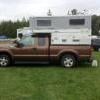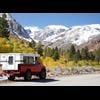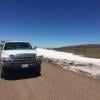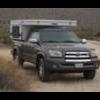It sounds like everything including the furnace works well on shore power but not on battery because on battery power alone the furnace needs more watts than the battery can supply. So let's start out by getting some more information about why that is.
If I had to guess one thing, I'd say that when on battery power something, probably the refrigerator, is putting such a high amperage load on your battery that the furnace doesn't get what it needs to run properly. One easy test is to turn off everything in the camper except the furnace and see if the furnace runs properly when the battery is fully charged. For instance, if you have a 3-way refrigerator and it's set to be powered by DC when on battery power, be sure to turn the refrigerator off when you do this test. That's because a 3-way refrigerator pulls a huge amperage load that will quickly run the battery down even if the truck is trying to charge it.
If that's not the problem, gather some more information. When you think the battery is fully charged, make sure that it is by letting it sit for at least half an hour after disconnecting one battery terminal to make sure there's no load on the battery while it's resting. The battery voltage should be at least 12.6 volts at rest if it's fully charged. If it's not, then something's wrong with the battery charging system as the battery isn't being fully charged. I don't know what sort of battery charge meter you have with the red and green light, but those systems are not accurate enough to tell you much. They measure voltage alone and changing from green to red shows there's enough current draw to cause the battery voltage to drop, but that's not much help.
It's odd about the two ceiling lights and their effect on the red/green charge meter. Both lights are on the same circuit fed by the wires running to the ceiling behind the front lifting board. Maybe the one over the kitchen is somehow drawing a lot more amperage than the light on the passenger side, but that seems quite odd. You could test the battery voltage when each light is on in turn; the voltage drop, if any is seen, should be the same if the fixtures and bulbs are similar.
You don't say if you're able to run the furnace of both lights are off. Can you?
So the problem again is either too much battery load when not on shore power or the battery isn't getting fully charged.
The third possibility is that there's a poor electrical connection somewhere between the shore power battery charger and the battery. I assume you have an Iota charger that takes the 120 volt shore power and converts it to 12 volt DC to both charge the battery and run all the 12v appliances. Since the battery charges at a much lower rate than the furnace draws power, it could be a partially-broken wire or bad connection leading to the battery that lets enough electricity through to charge the battery but is inadequate for the load from the battery needed to power the furnace.
I hope you have a voltmeter. Nothing fancy, but it's a vital tool for situations like this.
Keep us posted.



















